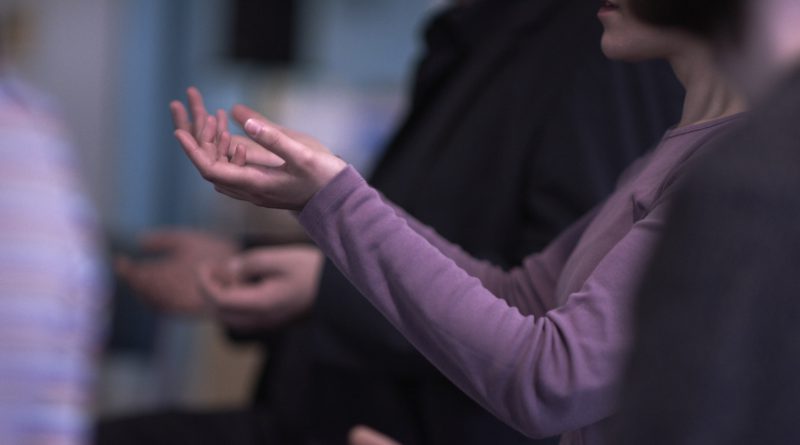The politics of somatics
By Ben Spatz
Photo: Nazlıhan Eda Erçin in the Judaica Project (Garry Cook, 2017)
Helping to develop this “Somatics Toolkit” has been challenging for me. My research these days is devoted to thinking about the political implications of embodied practices. When we practice yoga or martial arts, when we sing or dance, when we attend to our bodies — how are we also contributing to public understandings of embodiment, knowledge, identity, and power?
So much of the discourse around embodied practice has to do with letting go of unrealistic attachments to the large-scale social repercussions of our individual actions. While we worry about the increase of racist and nationalist movements around the globe and the continuing destruction of ecologies and mass extinctions of plants and animals, it is easy to feel paralyzed and disembodied — perhaps even disassociated. In that sense, somatic practices can be understood as a necessary part of personal healing. When the work of the world is simply too much, I can stop and put my attention back on my breath, my balance, the sensation of having skin. This is another way of being in the world, which we forget at our grave peril.
But many discussions of somatics go further than this, suggesting that such practices do more than simply heal the individual. Can the “return to the body” be linked to a broader return to more ecological consciousness? Can the somatic be healing not just to individual bodies but at the communal or even social level? Can there be a politics of somatics? I believe there can be, but this does not happen automatically, it has to be consciously developed.
My first concern about the Somatics Toolkit was that it not participate in the widespread selling of mindfulness as a commercial product. (I’ve written about the earlier rise of commercial yoga in my book What a Body Can Do.) Since our toolkit is free, we avoid the most obvious kind of commercial exploitation. But I still feel uncomfortable with the idea of a toolkit that is designed to be for everyone, neutral, apolitical, generic. The problem for me isn’t the charging of money itself but the lack of a critical stance. It is true that exercises related to breathing and sensation connect to some of the deepest and most fundamental ways of being human. In that sense they are truly universal, applying equally to everyone, and in this sense perhaps they can model a kind of radical democracy. But what does this really amount to?
Do we really imagine that someone who is engaged in acts of social or ecological violence — such as building pipelines to transport oil across continents, or maintaining prisons in a racist, class-based system — will discover through somatic practices that they need to change their life? This could only happen if, embedded in our notion of the somatic, were some concrete links to the political. If we teach somatic techniques as something that is simply, obviously universal, then they will be learned that way. Scholar, waitress, Amazon restocker, tech engineer, investment banker, and politician will all benefit from them in similar ways. Will there be some magical, automatic, positive effect on larger issues through the dissemination of the tools alone? I think it is naive to rely on this.
What I’d like to explore in this blog is the question of how we might embed a more critical perspective into the toolkit itself. One obvious resource for this would be the conversations around yoga and whiteness, yoga and cultural appropriation, and decolonizing yoga. There is similar work happening around contact improvisation, such as in Earthdance’s Political Movement workshop. These kinds of initiatives position themselves directly against mainstream commercial or “whitestream” theories and practices of embodiment, where one can find a mass of predominantly white faces billed as “the world’s leading embodiment teachers” without any critical awareness of the irony — not to say, rank neocolonialism — of this claim.
There are complicated issues to untangle here, but some first steps could be:
- Acknowledge the limitations of whiteness in both the university research setting of the project and the sources of somatic knowledge that the toolkit draws upon.
- Investigate the concept of “somatics” and articulate how this generic term draws upon (and appropriates) specific nonwestern, indigenous, and global south knowledges.
- Expand the toolkit to include contributions from somatics practitioners outside the core team, who are working from a critical/decolonial perspective, and direct resources (including payment) to them.
- Find ways to embed critical, decolonial, and ecological awareness in the fabric and details of the toolkit exercises themselves.
The last of these feels like the most difficult and perhaps one of the more useful contributions that our project could make. I hope that, in the end, we will be able to offer a toolkit that appeals to universal capacities like breath and body without carrying forward any willful ignorance as to the reality of ongoing social and ecological violence. In any case, I am sure that by having such conversations around the toolkit — on the website and in future publications — we can both strengthen the toolkit itself and increase its value in the world.

